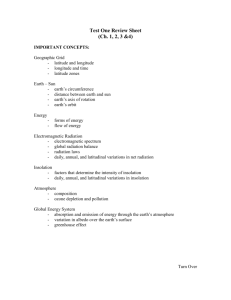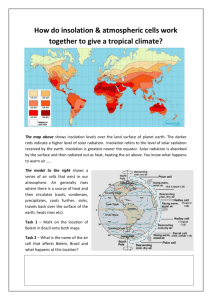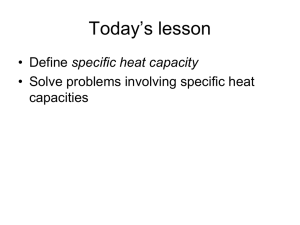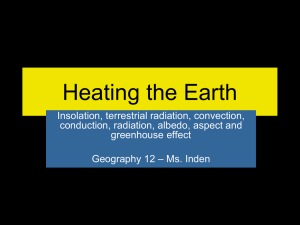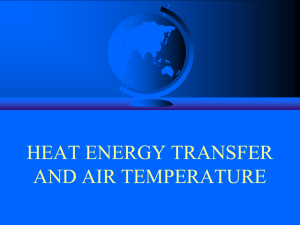ppt
advertisement
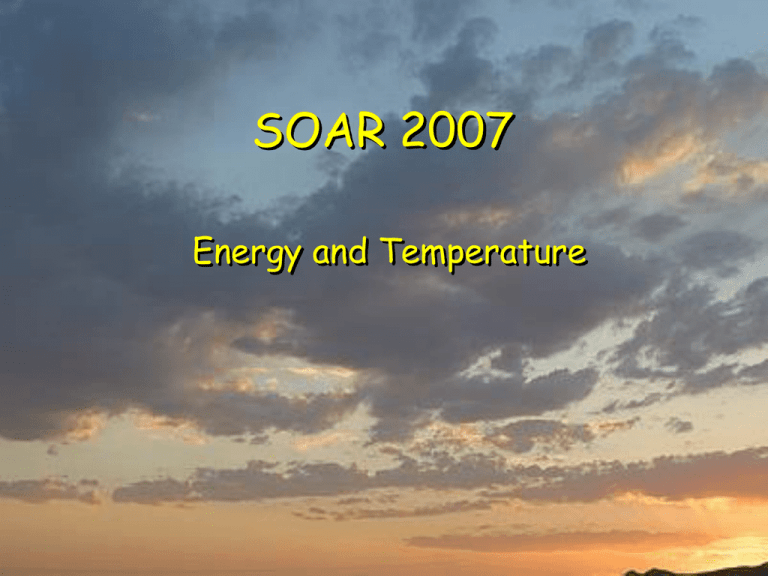
SOAR 2007 Energy and Temperature Energy & Temperature Insolation Spectrum Distribution with latitude Distribution with albedo Interaction with Air, Land & Water Reflected Absorbed by atmosphere Absorbed by land Absorbed by water Effect of insolation Heating & temperature Temperature Scales (Again!) Celsius 0 - fresh water freezes 100 - fresh water boils at 1013.2 hPa Kelvin (1 atm) Plots for different gases meet at -273 C Pressure Based on gases TC + 273 = TK -273 Temperature C Fahrenheit – used only in US 0 ~ salt water freezes 100 ~ human body temp. TC = (5/9)(TF - 32) TF = (9/5)TC + 32) Celsius – Fahrenheit touch points: -40 C = -40 F 16 C = 61 F 28 C = 82 F Temperature Scales Celsius – Fahrenheit touch points: 28C ≈ 82F 16C ≈ 61F -40C = -40F “At 40 below it doesn’t matter!” Atmospheric “Windows” Solar Radiation air transparent to some (visible, radio, some IR) opaque to others (some IR & UV, all X- & -rays) Solar Radiation & Latitude Latitude Latitudes close to equator get more annual sun Tropics 23.5 N - Tropic of Cancer 23.5 S - Tropic of Capricorn Polar Regions 66.5 N – Arctic Circle 66.5 S – Antarctic Circle Sun directly overhead on solstice Sun does not set (or rise) on solstice Sun Angle & Latitude At the Equator, the noontime sun goes from 23.5 South of the zenith to 23.5 North ofsun theiszenith. At the Tropic of Cancer, the noontime directly overhead on Allthe days have 12summer daylight. 21.5 above the northern solstice. In Insolation Canton, the noontime sun goes from 45-23.5= depends onhours sunof angle. horizon to the 45-23.5= At the Arctic Circle, sun goes68.5 fromabove beingthe justhorizon. at the horizon on Sunsolstice Angle Through the Year the winter to 47 above the horizon. 120 Angle above Horizon No-shadow days! 90 Highest angle changes by 47° from 21.5° to 68.5° 60 Point of sunrise & sunset changes by 68° From azimuth 56° to 124° (90° is east) 30 0 J F M A M J J A S O N D Insolation in Canton Summer sun 21.5 ~500W falls on ~665W falls on 2 one m2 in Canton one m in Canton in spring & fall in summer ~700 W/m2 from sun reaches surface ~260W falls on one m2 in Canton in winter Insolation & Latitude Insolation & Latitude Tropics energy surplus Poles energy deficit Energy must be transported to poles Latitude & Temperature Temperature plots of data from worldclimate.com Temperatures at Different Latitudes 40 Shuwaikh, Kuwait, 30N Degrees C 30 Pakanbaru, Indonesia, 0S 20 10 Venice, Italy 45N 0 J F M A M J J A S O N D Reflected Radiation -- Albedo Different surfaces reflect differently Melting ice & snow increases absorption, enhances heating “Ice-Albedo Effect” Melting sea ice increases absorption, enhances heating Insolation on Earth’s Surface Distributed by latitude & vegitation Deserts get > 200 W/m2 Rainforests get less due to clouds Insolation Short wave radiation visible light emitted by Sol (the sun) absorbed by land & water not absorbed by air Long wave radiation infrared (IR) emitted by Earth absorbed by air, land & water Simplified Energy Budget Shortwave radiation from sun (light) absorbed by Earth (land & water) Earth heats & emits longwave radiation Top of the atmosphere receives 1372 W/m2 - solar constant 10 W = power to lift 1 kg 1 meter in 1 second Energy Budget Insolation – incoming solar radiation reflected & absorbed ~30% reflected Energy Budget Insolation – incoming solar radiation reflected & absorbed ~30% reflected Outgoing shortwave reflected from clouds and deserts, absorbed by ocean & forests Energy Budget Insolation – incoming solar radiation reflected & absorbed ~70% re-radiated ~30% reflected ~19% absorbed by air & clouds ~51% absorbed by surface Energy Budget Insolation – incoming solar radiation reflected & absorbed ~70% re-radiated Outgoing longwave radiated by surfaces ~51% absorbed by surface Energy Budget Insolation Sun’s incident energy drives air motions (energy from deep interior adds a tiny bit) Distribution of Sunlight Reflection from clouds, landscape Absorption by atmosphere Absorption by surface Albedo = ratio of sunlight reflected Earth: 0.367 Moon: 0.113 Mars: 0.15 Venus: 0.84 Energy Distribution Convection – hot stuff moves Conduction – hot stuff heats neighbors Radiation – heat moves as IR radiation Insolation: 1,373 W/m2 Most solar energy comes in as light (shortwave radiation) 30% Reflected by atmosphere & surface 20% Absorbed by atmosphere 50% Absorbed by Earth’s surface Insolation: 1,373 W/m2 of Most solar Reflection energy comes in as sunlight light (shortwave radiation) Air 30% Clouds Reflected by atmosphere & surface 20% Absorbed by atmosphere Surface 50% Absorbed by Earth’s surface Energy Emitted by Planet Earth % of total insolation 30% reflected directly to space 70% emitted as IR Energy Flow from Surface 7% conducted to air 23% transferred by water 20% radiated as IR (longwave) ~ 50% of total insolation absorbed by surface Energy Absorbed by Atmosphere % of total insolation 20% from Sun 7% conducted from surface 23% transferred by water 8% radiated by surface Energy Absorbed by Atmosphere % of total insolation 20% from Sun 7% conducted from surface 23% transferred by water 8% radiated by surface Urban Heat Islands Structures and pollution increase heat Urban Heat Islands May be giving false increases in global temperature since most weather stations are at airports in urban areas! Energy Absorbed by Atmosphere % of total insolation 20% from Sun 7% conducted from surface 23% transferred by water 8% radiated by surface Energy Transfer by Water Latent heat effects weather Evaporating water absorbs energy from water, cooling it. Condensing water releases energy to air, heating it. Energy Absorbed by Atmosphere % of total insolation 20% from Sun 7% conducted from surface 23% transferred by water 8% radiated by surface Easterlies Westerlies NE Trades Moist air rising stormy Dry air falling Arid Moist air rising stormy SE Trades Westerlies Easterlies Dry air falling Arid Moist air rising stormy Atmospheric Circulaton Ground conducts heat to adjacent air Heated air rises Troposphere cools with altitude Environmental lapse rate Inversion = warmer air aloft Energy Absorbed by Atmosphere % of total insolation 20% from Sun 7% conducted from surface 23% transferred by water 8% radiated by surface Greenhouse Effect Light from sun gets absorbed by Earth Earth radiates infrared Greenhouse Effect Light from sun gets absorbed by Earth Earth radiates infrared infrared Earth re-emits energy absorbed from sunlight as infrared Greenhouse Effect IR gets absorbed by atmosphere Air heats Air absorbs more water Moist air absorbs more IR & heats more absorbs more water Global Warming Increasing greenhouse gases decreases longwave (IR) radiation lost to space Increasing greenhouse gases increases absorption of longwave (IR) radiation by ground Venus: Greenhouse gone wild! The difference between Earth and Venus! Complete Energy Budget Sunlight & Temperature Noon not warmest time of day Solstice not warmest time of year Temperature waits for surface to heat air! Insolation on Land and Water Land Light heats surface, some downward conduction no downward transmission or convection Conduction to subsurface very slow Water Surface molecules evaporate, cooling surface Light penetrates to depths, heats subsurface Heats slowly due to high specific heat Convection moves heat across surface and beneath surface … currents Land and Water Water distributed heat more than land Energy Absorbed by Water Specific Heat Energy absorbed/released to change temp. Latent Heat Energy needed to change phase (substance remains at same temperature) Energy Absorbed by Water Specific Heat Energy absorbed or released to change temp. Raising 1 kg of water 1°C absorbs 4,168 Joules 1 kg 10 cm square cube of water Substance Specific Heat (Joule/K/kg) Air (50C) 1050 Iron or Steel 460 Lead 130 Glass 840 Quartz 762 Granite 804 Sandstone 1088 Shale 712 Soil (average) 1050 Wood (average) 1680 Ice 2100 Steam 2050 Water 4168 4000 Joules ≈ energy to lift 400 kg or 900 lb 1 m Energy Absorbed by Water Latent Heat Specific Heat (Joule/kg) Energy absorbed or Substance released to change phase vaporization Evaporating 1 kg of water absorbs 2,257,000Joules 1 kg fusion Alcohol 879,000 109,000 Water 2,257,000 333,500 10 cm square cube of water 2,257,000 Joules ≈ energy to lift 225,700 kg or 507,000 lb 1 m Land and Water Maritime climates milder than continental 0 100 Rainfall (mm) Ju ly M Au gu Se st pt em be r O ct ob er No ve m De be r ce m be r -20 Ju ne 0 ay -10 Ap ril 50 Solar Angle Average Temp-erature (C) 20 200 10 150 0 100 50 -10 0 -20 Rainfall (mm) Au gu Se st pt em be r O ct ob er No ve m De be r ce m be r 150 250 Ju ly 10 30 Ju ne 200 300 ay 20 Ja nu ar y Fe br ua ry M ar ch Rainfall (mm) 250 40 M 30 350 Ap ril 300 Rainfall (mm) 40 Ja nu ar y Fe br ua ry M ar ch 350 Solar Angle Average Temp-erature (C) Monthly average temperature varies by 14 C in Seattle, 35 C in Minot Temp (C), Sun Angle ((Degrees/2) Minot, ND, 48 N, continental Temp (C), Sun Angle ((Degrees/2) Seattle, 48 N, maritime Atmospheric Water & Warming Clouds & Rain clouds reflect sunlight, shade ground so cloudy places should be cool … moist air absorbs more IR than dry 15 10 100 5 50 0 Rainfall (mm) Au gu Se st pt em be r O ct ob er No ve m De be r ce m be r Ju ly Ju ne M ay -5 Ap ril 0 Solar Angle Average Temp-erature (C) 30 200 20 150 10 100 0 50 -10 0 -20 Rainfall (mm) Ju ly Au gu Se st pt em be r O ct ob er No ve m De be r ce m be r 150 250 Ju ne 20 40 ay 25 200 300 M 30 Ja nu ar y Fe br ua ry M ar ch Rainfall (mm) 250 50 Ap ril 35 Rainfall (mm) 40 300 350 Ja nu ar y Fe br ua ry M ar ch 45 Temp (C), Sun Angle ((Degrees/2) 350 Solar Angle Average Temp-erature (C) Temp (C), Sun Angle ((Degrees/2) so humid places should stay warm … Monsoon rains cool Lhasa and Calcutta. Atmospheric Water & Warming More evaporation more clouds surface shaded surface cools atmosphere cools Negative feedback prevents runaway warming Atmospheric Water & Warming More evaporation more clouds more IR absorption atmosphere warms Positive feedback enhances runaway warming Ocean Currents Surface currents move warm water toward poles Gulf Stream warms east coast of US and Europe Ocean Currents Sea Surface Temperature monitored by satellites, augmented by buoy array. Hurricanes Equator 9/26/07 http://www.ssec.wisc.edu/data/sst.html Winter Temperature Patterns Landforms, water, latitude affect temps. Gulf Stream pushes isotherms toward arctic Evenly spaced isotherms over uninterrupted ocean. Siberia gets as cold as Greenland’s Icesheet! Dramatic Temp. changes at mountains, shores Frozen landscape pushes isotherms toward equator Summer Temperature Patterns Landforms, water, latitude affect temps. Gulf Stream pushes isotherms toward arctic Evenly spaced isotherms over uninterrupted ocean. Warmed landscape pushes isotherms toward mountains Annual Range of Temperatures Continental climates most extreme Siberia varies by 60 C = (108 F) Temperature of equatorial ocean barely varies. “Summer” and “Winter” don’t make sense everywhere!

